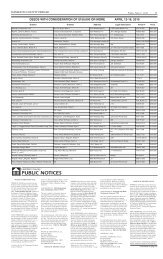Home staging gives sellers a leg up - Chattanooga Bar Association
Home staging gives sellers a leg up - Chattanooga Bar Association
Home staging gives sellers a leg up - Chattanooga Bar Association
Create successful ePaper yourself
Turn your PDF publications into a flip-book with our unique Google optimized e-Paper software.
24 | Friday, March 16, 2012 Hamilton County Herald www.hamiltoncountyherald.com<br />
Counseling clients on<br />
home improvements<br />
First and foremost, never counsel before you are hired. Counseling<br />
happens after a client-relationship is established. Attorneys<br />
don’t off er <strong>leg</strong>al advice before their services have been offi cially<br />
retained. Doctors don’t diagnose without assurance of compensation.<br />
Realtors should follow suit. Wait until the listing agreement is<br />
signed. � en begin to give counsel regarding how the owner can realize<br />
a quicker sale or higher price by making recommended home<br />
improvements and implementing <strong>staging</strong> advice.<br />
Too frequently, agents give away their expert counsel during<br />
listing presentations in hopes of proving their ability and expertise<br />
to <strong>sellers</strong>. More often than not, though, the <strong>sellers</strong> simply take the<br />
counsel with them when they link <strong>up</strong> with an agent who is less skillful<br />
but who promises a cheaper fee.<br />
• Second, tell the truth. If the <strong>sellers</strong> need to clean the home, tell<br />
them. If they are smokers and the house reeks from cigarettes, tell<br />
them.<br />
I once had to convince some clients to hire professional cleaners<br />
to rid their home of the smoke smell that permeated the carpets,<br />
walls and furniture throughout the entire home. � en I made them<br />
promise not to light <strong>up</strong> again for so long as they owned the house.<br />
� ey agreed under protest, but we sold the home, so they were happy.<br />
� e wrong odor in a home can really lower the odds of a sale.<br />
Likewise, appearances can kill buyer interest. If the home is<br />
crowded with too much stuff , say so. If the pink exterior color will<br />
cause people to drive right on by, speak <strong>up</strong>. Holding your tongue<br />
will only delay the day of reckoning. What’s more, it’s easier to be<br />
totally frank when you fi rst notice the problem – though only after<br />
the listing contract is signed. If you counsel before you gain commitment,<br />
your advice could off end the <strong>sellers</strong> and cost you the listing.<br />
� is is another reason to follow Rule No. 1 and get a signature<br />
before giving counsel.<br />
Improvements that contribute to the sales price<br />
When it comes to preparing a home for sale, worthwhile and<br />
necessary improvements fall into three categories:<br />
• Improvements that bring a home back to standard.<br />
• Improvements that correct defects.<br />
• Improvements that enhance curb appeal or fi rst impressions.<br />
� e following sections provide guidelines in each area.<br />
Bringing a home back to standard<br />
Coach’s<br />
Corner<br />
By Dirk Zeller<br />
Before you present a home with horribly dated décor, counsel<br />
the <strong>sellers</strong> to modernize the interior look in order to align it with<br />
the expectations of current-market buyers. <strong>sellers</strong> don’t have to go<br />
overboard; they just need to install a reasonable color scheme and<br />
implement enough of an <strong>up</strong>date so that new owners will feel they<br />
can move in without having to undertake an immediate facelift.<br />
Share the following advice with <strong>sellers</strong>:<br />
• Keep improvements simple. A total redecoration isn’t necessary<br />
or even advisable. � e objective is to arrive at a widely acceptable<br />
and reasonably current color scheme in paint, counters, and<br />
fl oor coverings.<br />
• Don’t aim to create a design showpiece. Realize that following<br />
the purchase buyers will often change a home signifi cantly to<br />
make it their own. � e <strong>sellers</strong>’ objective is to allow them to feel that<br />
their changes can happen in time over the next years; that they’re<br />
not glaringly and immediately necessary<br />
• Focus on the big stuff . If the interior of a home looks current<br />
and the landscaping, yard, decks and patios are well kept and<br />
serviceable, the onus on buyers to make signifi cant, immediate<br />
changes lightens. As a result, they’ll be more likely to buy the home.<br />
� ey’ll also be more apt to make a more competitive initial off er<br />
than would be the case if the home presented obvious exterior or<br />
interior color or repair issues. Any changes a buyer has to make<br />
to a home comes out of money they must have, not money they<br />
can borrow. Many buyers will use that fact as one of the factors of<br />
which home they buy now.<br />
• A little paint makes a huge diff erence. Repainting is one of<br />
the most cost eff ective ways to freshen the look of a home and even<br />
to disguise design shortcomings.<br />
• Steer clear of the latest trends. Counsel clients away from<br />
the current rage in deep wall colors. Advise them to create a warm,<br />
blank canvas that any prospective buyer can work with.<br />
��HEALTH CORNER<br />
Crash course on diabetes<br />
By Kay Bona<br />
Recently, a close friend of mine<br />
was diagnosed with Diabetes<br />
Type II. Over 17 million Americans<br />
have diabetes, and each day,<br />
approximately 2,200 new individuals<br />
are diagnosed. After my<br />
friend was diagnosed, I realized<br />
my knowledge of diabetes was<br />
lacking. Below is a simple test on<br />
the subject – how much do you<br />
know?<br />
1. Onset of Type II diabetes<br />
most likely occurs:<br />
a. in childhood or adolescence<br />
b. at ages 20 to35<br />
c. at ages 35 to 65<br />
d. at 65+<br />
2. Which of the following is<br />
NOT a symptom of diabetes?<br />
a. hair loss<br />
b. frequent urination<br />
c. fatigue<br />
d. sores that don’t heal<br />
3. Which is the most appropriate<br />
test for diagnosing<br />
diabetes?<br />
a. fasting plasma glucose blood<br />
test<br />
b. urine test<br />
c. fi nger-stick test<br />
d. saliva test<br />
4. � e role of insulin in our<br />
system is:<br />
a. to break down carbohydrates<br />
b. to aid Alpa Cells, which are<br />
responsible for the production of<br />
glucagons<br />
c. to store glucose in our cells<br />
to use as fuel<br />
d. to regulate our level of metabolism<br />
5. “Borderline Diabetes”<br />
refers to:<br />
a. a person with Gestational<br />
Diabetes<br />
b. a person with mild diabetes<br />
c. there is no such thing as<br />
“Borderline” diabetes<br />
d. a condition known as impaired<br />
glucose tolerance (IGT)<br />
Answers:<br />
1. D. � e incidence of Type<br />
II diabetes drastically increases<br />
with age.<br />
2. A. Hair loss is not a symptom<br />
of diabetes.<br />
3. A. � e fasting plasma glucose<br />
blood test is the preferred<br />
test. Finger-sticks and urine tests<br />
are more suitable as a screening<br />
tool and regular glucose monitoring.<br />
4. C. When glucose enters our<br />
blood, insulin moves it into our<br />
cells to be used as fuel.<br />
5.C. “Borderline” diabetes does<br />
not exist, although the term is<br />
used quite frequently.<br />
Insulin and diabetes facts:<br />
Type II Diabetes is the most<br />
common type of diabetes. Type I<br />
Diabetes usually strikes in young<br />
persons (average age is 14), with<br />
Type II Diabetes typically developing<br />
during or after middle age,<br />
often referred to as “adult onset<br />
diabetes”.<br />
Diabetes is a condition where<br />
insulin, a hormone, is not doing<br />
its job. Insulin is needed<br />
to properly store foods we eat<br />
for use as energy. Here’s how<br />
it works: Most of the food we<br />
consume is broken down into<br />
glucose and other simple sugars.<br />
As newly arrived glucose enters<br />
our blood stream, insulin is<br />
released from the pancreas, binds<br />
to the glucose via Insulin Receptors,<br />
and moves it into your cells<br />
to use as fuel.<br />
If insulin production is insuffi<br />
cient or does not function properly,<br />
the newly arrived glucose<br />
cannot be stored and remains<br />
in our blood stream - our blood<br />
sugar levels then become elevated.<br />
� ese high levels, left untreated,<br />
can eventually cause damage<br />
to other systems and organs.<br />
With Type II Diabetes, the<br />
pancreas produces some insulin,<br />
but the amount is either<br />
not enough or is not eff ective,<br />
because the body’s cells are resistant<br />
to it.<br />
Type I Diabetes must be treated<br />
with insulin, which involves<br />
injections. Insulin cannot be<br />
taken as a pill because the digestive<br />
juices in the stomach destroy<br />
the insulin before it can work.<br />
The warning signs of diabetes<br />
include:<br />
• Frequent urination<br />
• Blurred vision<br />
• Unusual thirst<br />
• Numbness or tingling in the<br />
extremities<br />
• Intense hunger<br />
• Frequent infections/slowly<br />
healing cuts<br />
• Fatigue<br />
• Irritability<br />
Ten tips for diabetes control<br />
1. Monitor your blood sugar<br />
at least twice (preferably three<br />
times) a day – before meals.<br />
2. Take your medication<br />
correctly, read and following<br />
directions, and pay attention to<br />
warning labels.<br />
3. Read food labels – the fi rst<br />
8/3/11<br />
thing to look at is serving size.<br />
� en look at the carbohydrate<br />
per serving. Look also at the fat<br />
and calories, if appropriate.<br />
4. Eat at regular times - stay<br />
within one hour each day of usual<br />
meal times. Controlling your eating<br />
schedule helps control your<br />
blood sugar and lead to better<br />
management.<br />
5. Learn the carbohydrate<br />
count of foods in the portions<br />
you commonly use. Use measuring<br />
c<strong>up</strong>s to measure serving<br />
sizes and count out servings of<br />
crackers, pretzels, chips and nuts.<br />
Carbohydrate control is essential<br />
in diabetes management.<br />
6. Make wise selections when<br />
dining out. Eat smaller portions,<br />
order salad dressing on the side<br />
and dip with your fork, and avoid<br />
“sugar free” desserts, having a<br />
bite or two of regular dessert<br />
instead.<br />
7. Exercise daily with some<br />
type of walking, biking, swimming,<br />
dancing or aerobics. Exercise<br />
improves your body’s use of<br />
insulin.<br />
8. Examine feet daily. Diabetics<br />
are more prone to foot problems.<br />
Always wear proper fi tting<br />
shoes.<br />
9. Take care of your heart!<br />
Heart disease causes 65 percent<br />
of deaths related to diabetic complications.<br />
Maintain good body<br />
weight, exercise and decrease the<br />
saturated fats.<br />
10. Know your A1c Hemoglobin<br />
number – this is the<br />
measurement of sugar over the<br />
past three months which tells the<br />
degree of diabetes control.<br />
Diabetes is a serious condition.<br />
However, with proper treatment<br />
and a healthy lifestyle, your blood<br />
glucose can go down to normal<br />
levels.<br />
So, the next time you hear<br />
someone claim they have “a<br />
touch of sugar” or just “borderline”<br />
diabetes, do him or her a<br />
favor: Tell them all diabetes is<br />
important, and careful monitoring<br />
and treatment is crucial. ��<br />
©2011 The Mepham Gro<strong>up</strong>. Distributed by<br />
Tribune Media Services. All rights reserved.<br />
Level:<br />
1 2<br />
3 4<br />
Complete the grid so<br />
each row, column and<br />
3-by-3 box (in bold<br />
borders) contains<br />
every digit, 1 to 9. For<br />
strategies on how to<br />
solve Sudoku, visit<br />
www.sudoku.org.uk<br />
SOLUTION TO<br />
TUESDAY’S PUZZLE<br />
Last weeks solution
















